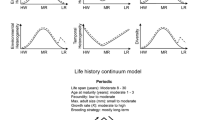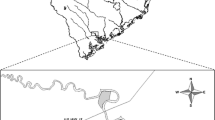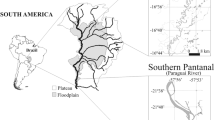Abstract
Despite estuary-to-estuary differences in assemblage composition, fish faunas of tropical Indo-Pacific estuaries show parallel patterns of temporal change, suggesting a common set of ecological drivers. One potentially important driver is the interaction of different patterns of occupancy by functional groups that display different life-history patterns. However, most studies that have considered temporal change lack the detail needed to understand life-history utilisation. Most have focussed on changes in catch per unit effort (CPUE) or probability of encounter, with only one study going further and investigating changes in size structure and then only for a single estuary. One of the reasons for this lack of detail is the large volume of work needed to collect comprehensive data on size structures of species rich assemblages across multiple estuary systems over time. To overcome the logistical limitations on data collection, we used joint patterns of change in CPUE and mean biomass per fish (BPF) as proxies for changes in size structure. We investigated how different life-history strategies contributed to overall temporal patterns of assemblage change across four tropical Indo-Pacific estuaries. The three life-history strategies displayed characteristically different patterns in CPUE and BPF and the relationships between CPUE and BPF that reflect differences in the way that the three groups use estuaries. These different patterns interacted to produce complex assemblage patterns that are likely to be sensitive to location-specific differences in the mix of species from each group, providing at least part of the explanation for the site-specific fish assemblage structures that are characteristic of tropical estuarine fish fauna.







Similar content being viewed by others
References
Aiken, S., E. Buhan, K.O. Winemiller, and H. Yilmaz. 2005. Fish assemblage structure of Koycegiz Lagoon-Estuary, Turkey: spatial and temporal distribution patterns in relation to environmental variation. Estuarine, Coastal and Shelf Science 64: 671–684.
Armsworth, P.R. 2002. Recruitment limitation, population regulation, and larval connectivity in reef fish metapopulations. Ecology 83: 1092–1104.
Bacheler, N.M., J.E. Hightower, S.M. Burdick, L.M. Paramorec, J.A. Buckela, and K.H. Pollock. 2010. Using generalized linear models to estimate selectivity from short-term recoveries of tagged red drum Sciaenops ocellatus: effects of gear, fate, and regulation period. Fisheries Research 102: 266–275.
Baker, R., and T.J. Minello. 2011. Trade-offs between gear selectivity and logistics when sampling nekton from shallow open water habitats: a gear comparison study. Gulf and Caribbean Research 23: 37–48.
Baker, R., and M. Sheaves. 2009a. Refugees or ravenous predators: detecting predation on new recruits to tropical estuarine nurseries. Wetlands Ecology and Management 17: 317–330.
Baker, R., and M. Sheaves. 2009b. Overlooked small and juvenile piscivores dominate shallow-water estuarine “refuges” in tropical Australia. Estuarine, Coastal and Shelf Science 85: 618–626.
Barletta, M., A. Barletta-Bergan, U. Saint-Paul, and G. Hubold. 2005. The role of salinity in structuring the fish assemblages in a tropical estuary. Journal of Fish Biology 66: 45–72.
Blaber, S.J.M. 1980. Fish of the Trinity Inlet system of north Queensland with notes on the ecology of fish faunas of tropical Indo-Pacific estuaries. Australian Journal of Marine & Freshwater Research 31: 137–146.
Blaber, S.J.M. 2002. ‘Fish in hot water’: the challenges facing fish and fisheries research in tropical estuaries. Journal of Fish Biology 61A: 1–20.
Blaber, S.J.M., and T.G. Blaber. 1980. Factors affecting the distribution of juvenile estuarine and inshore fish. Journal of Fish Biology 17: 143–162.
BOM. 2009. Australian Bureau of Meterology. Australian Department of Environment, Water, Heritage and the Arts, Canberra. http//www.bom.gov.au. Accessed 5 Dec 2011.
Breiman, L., J. Friedman, R. Olshen, and C. Stone. 1984. Classification and regression trees. Belmont: Wadsworth International Group. 358 pp.
Catalano, M.J., and M.S. Allen. 2010. A size- and age-structured model to estimate fish recruitment, growth, mortality, and gear selectivity. Fisheries Research 105: 38–45.
De'ath, G., and K.E. Fabricius. 2000. Classification and regression trees: a powerful yet simple technique for ecological data analysis. Ecology 81: 3178–3192.
Deegan, L.A., J.E. Hughes, and R.A. Rountree. 2000. Salt marsh ecosystem support of marine transient species. In Concepts and controversies in Tidal Marsh Ecology, ed. M.P. Weinstein and D.A. Kreeger, 333–365. Dordrecht: Kluwer Academic Publishers.
Elliott, M., A.K. Whitfield, I.C. Potter, S.J.M. Blaber, D.P. Cyrus, F.G. Nordlie, and T.D. Harrison. 2007. The guild approach to categorizing estuarine fish assemblages: a global review. Fish and Fisheries 8: 241–268.
Fontes, J., J.E. Caselle, P. Afonso, and R.S. Santos. 2009. Multi-scale recruitment patterns and effects on local population size of a temperate reef fish. Journal of Fish Biology 75: 1271–1286.
Forrester, G.E., R.R. Vance, and M.A. Steele. 2002. Simulating large-scale population dynamics using small-scale data. In Coral reef fishes, dynamics and diversity in a complex ecosystem, ed. P.F. Sale, 275–302. London: Academic.
Franco, A., M. Elliott, P. Franzoi, and P. Torricelli. 2008. Life strategies of fishes in European estuaries: the functional guild approach. Marine Ecology Progress Series 354: 219–228.
Froese, R., and D. Pauly. 2010. FishBase: World Wide Web electronic publication. www.fishbase.org. Accessed 5 Dec 2011.
Garcia, A.M., J.P. Vieira, K.O. Winemiller, L.E. Moraes, and E.T. Paes. 2012. Factoring scales of spatial and temporal variation in fish abundance in a subtropical estuary. Marine Ecology Progress Series 461: 121–135.
Hixon, M.A., S.W. Pacala, and S.A. Sandin. 2002. Population regulation: historical context and contemporary challenges of open vs. closed systems. Ecology 83: 1490–1508.
Horppila, J., P. Eloranta, A. Liljendahl-Nurminen, J. Niemisto, and Z. Pekcan-Hekim. 2009. Refuge availability and sequence of predators determine the seasonal succession of crustacean zooplankton in a clay-turbid lake. Aquatic Ecology 43: 91–103.
Johnston, R., and M. Sheaves. 2008. Cross-channel distribution of small fish in tropical and subtropical coastal wetlands depends on their trophic and taxonomic identities and on wetland depth. Marine Ecology Progress Series 357: 255–270.
Juanes, F., and D.O. Conover. 1995. Size-structured piscivory: advection and the linkage between predator and prey recruitment in young-of-the-year bluefish. Marine Ecology Progress Series 128: 287–304.
Kritzer, J.P., and P.F. Sale. 2004. Metapopulation ecology in the sea: from Levins' model to marine ecology and fisheries science. Fish and Fisheries 5: 131–140.
Ley, J.A. 2005. Linking fish assemblages and attributes of mangrove estuaries in tropical Australia: criteria for regional marine reserves. Marine Ecology Progress Series 305: 41–57.
Osman, R.W., and R.B. Whitlatch. 2004. The control of the development of a marine benthic community by predation on recruits. Journal of Experimental Marine Biology and Ecology 311: 117–145.
Ritter, A.F., and R.K. Preisler. 2006. Spatial variation in structure of an intertidal fish assemblage reflects daily settlement patterns. Marine Ecology Progress Series 317: 211–223.
Robertson, A.I., and N.C. Duke. 1990a. Recruitment, growth and residence time of fishes in a tropical Australian mangrove system. Estuarine, Coastal and Shelf Science 31: 723–743.
Robertson, A.I., and N.C. Duke. 1990b. Mangrove fish-communities in tropical Queensland, Australia: spatial and temporal patterns in densities, biomass and community structure. Marine Biology 104: 369–379.
Sheaves, M.J. 1992. Patterns of distribution and abundance of fishes in different habitats of a mangrove-lined tropical estuary, as determined by fish trapping. Australian Journal of Marine & Freshwater Research 43: 1461–1479.
Sheaves, M. 1995. Large lutjanid and serranid fishes in tropical estuaries: are they adults or juveniles? Marine Ecology Progress Series 129: 31–40.
Sheaves, M.J. 1996. Habitat-specific distributions of some fishes in a tropical estuary. Marine and Freshwater Research 47: 827–830.
Sheaves, M.J. 2006. Scale dependent variation in composition of fish fauna among tropical estuarine sandy embayments. Marine Ecology Progress Series 310: 173–184.
Sheaves, M. 2009. The consequences of ecological connectivity: the example of the coastal ecosystem mosaic. Marine Ecology Progress Series 391: 107–115.
Sheaves, M., and R. Johnston. 2008. Influence of marine and freshwater connectivity on the dynamics of subtropical estuarine wetland fish metapopulations. Marine Ecology Progress Series 357: 225–243.
Sheaves, M., and R. Johnston. 2009. Ecological drivers of spatial variability among fish fauna of 21 tropical Australian estuaries. Marine Ecology Progress Series 385: 245–260.
Sheaves, M., and R. Johnston. 2010. Implications of spatial variability of fish assemblages for monitoring of Australia's tropical estuaries. Aquatic Conservation Marine and Freshwater Systems 20: 348–356.
Sheaves, M.J., B.W. Molony, and A.J. Tobin. 1999. Spawning migrations and local movements of a tropical sparid fish. Marine Biology 133: 123–128.
Sheaves, M., R. Johnston, and K. Abrantes. 2007. Fish fauna of dry sub-tropical estuarine floodplain wetlands. Marine and Freshwater Research 58: 931–943.
Sheaves, M., R. Johnston, and R. Connolly. 2010. Temporal dynamics of fish assemblages of natural and artificial tropical estuaries. Marine Ecology Progress Series 410: 143–157.
Sinclair, M., and T. Iles. 1989. Population regulation and speciation in the oceans. ICES Journal of Marine Science 45: 165–175.
Stevens, P.W. 2006. Sampling fish communities in saltmarsh impoundments in the northern Indian River Lagoon, Florida: Cast net and culvert trap gear testing. Florida Scientist 69:135–147.
Tobin, A., M. Sheaves, and B. Molony. 1997. Evidence of sex change in the tropical sparid, Acanthopagrus berda. Journal of Fish Biology 50: 22–33.
Acknowledgments
We thank the many volunteers who made the field work for this project possible. The work was supported by a Marine and Tropical Sciences Research Facility (MTSRF) research grant. Research was conducted under James Cook University Ethics Approval A1210.
Author information
Authors and Affiliations
Corresponding author
Rights and permissions
About this article
Cite this article
Sheaves, M., Johnston, R., Johnson, A. et al. Nursery Function Drives Temporal Patterns in Fish Assemblage Structure in Four Tropical Estuaries. Estuaries and Coasts 36, 893–905 (2013). https://doi.org/10.1007/s12237-013-9610-7
Received:
Revised:
Accepted:
Published:
Issue Date:
DOI: https://doi.org/10.1007/s12237-013-9610-7




